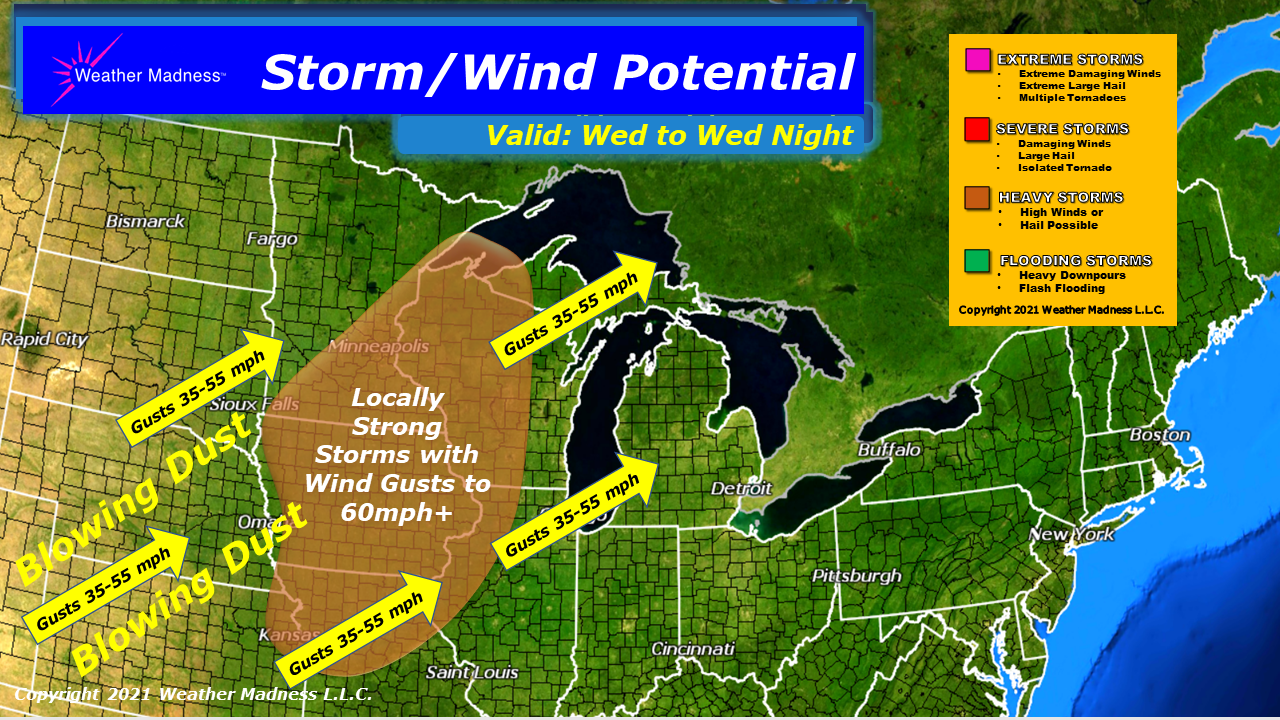Understanding Damaging Winds In Fast-Moving Storms

Table of Contents
The Physics of Damaging Winds in Fast-Moving Storms
Understanding how damaging winds form requires examining several key atmospheric phenomena.
Wind Shear and its Role
Wind shear, a significant contributor to the intensity of damaging winds, refers to a change in wind speed or direction over a relatively short distance. This change can be vertical (speed or direction changing with altitude) or horizontal.
- Definition of wind shear: A rapid change in wind speed and/or direction.
- Impact on storm intensification: Wind shear can tilt and strengthen thunderstorms, leading to increased intensity and the potential for stronger damaging wind speeds.
- Examples in different storm types: Wind shear plays a critical role in the formation and intensity of tornadoes, derechos, and severe thunderstorms. In tornadoes, wind shear contributes to the rotation within the mesocyclone. In derechos, wind shear helps create a long-lived line of strong thunderstorms.
Mesocyclone Formation and its Relation to High Winds
Mesocyclones are rotating updrafts within severe thunderstorms, often associated with extremely high wind speeds and the formation of tornadoes.
- Definition of mesocyclone: A rotating column of air within a thunderstorm, typically several kilometers in diameter.
- Process of formation: Mesocyclones form through the interaction of wind shear and strong updrafts within a supercell thunderstorm.
- Relationship to tornadoes: While not all mesocyclones produce tornadoes, they are a necessary precursor. The intense rotation within the mesocyclone is the parent for the smaller, more violent rotation of the tornado.
- Impact on wind damage: The intense rotation and powerful updrafts within a mesocyclone can generate incredibly high high wind speeds, resulting in catastrophic wind damage.
Downdrafts and Microbursts
Downdrafts and microbursts are strong, localized downdrafts of air that can produce incredibly powerful damaging wind speeds.
- Definition of downdrafts and microbursts: Downdrafts are descending air currents within a thunderstorm. Microbursts are extremely localized and intense downdrafts that can spread out rapidly upon reaching the ground, creating damaging straight-line winds.
- Their mechanisms: Downdrafts form as rain evaporates, cooling the surrounding air and making it denser, leading to its descent. Microbursts often involve heavy rainfall or hail that rapidly evaporates.
- Damage potential: Microbursts can produce extremely intense and sudden wind gusts, causing significant structural damage and posing a serious threat to aviation.
- Examples of microburst damage: Microbursts can cause widespread tree damage, down power lines, and damage to buildings.
Types of Fast-Moving Storms Producing Damaging Winds
Several types of fast-moving storms are notorious for generating damaging winds.
Derechos
Derechos are widespread, long-lived wind storms associated with a band of rapidly moving severe thunderstorms.
- Definition of derechos: Widespread, damaging winds extending for hundreds of kilometers.
- Their formation: Derechos are often associated with a bow echo or a squall line on radar.
- Typical wind speeds: Wind speeds exceeding 88 km/h (55 mph) are common, with gusts exceeding 120 km/h (75 mph) possible.
- Geographical areas affected: Derechos can affect large areas, causing widespread damaging winds across multiple states or provinces.
- Damage assessment: Damage from derechos is often characterized by widespread tree damage and structural damage due to the force of the straight-line winds.
Tornadoes
Tornadoes are violently rotating columns of air extending from a thunderstorm to the ground. They represent the most intense form of damaging winds.
- Definition of tornadoes: A violently rotating column of air, typically a few hundred meters wide, that is in contact with both the surface of the earth and a cumulonimbus cloud, or in rare cases, a dust cloud.
- Formation within supercell thunderstorms: Tornadoes form within supercell thunderstorms where strong updrafts, downdrafts, and wind shear interact.
- Wind speed variations: Tornado wind speeds vary greatly, but they can reach incredibly high speeds, well over 300 km/h (185 mph).
- Fujita scale: The Enhanced Fujita scale (EF-scale) is used to rate the intensity of tornadoes based on damage caused by high wind speeds.
- Tornado safety: Seeking shelter immediately is crucial when a tornado warning is issued.
Severe Thunderstorms
Even without tornadoes, severe thunderstorms can produce damaging wind gusts from various mechanisms.
- Characteristics of severe thunderstorms: Severe thunderstorms are characterized by strong winds, hail, and heavy rain.
- Factors contributing to high winds: Downdrafts, thunderstorm outflows, and gust fronts can all generate damaging winds.
- Thunderstorm outflows: As thunderstorms produce rain and downdrafts, cooler, denser air spreads outwards from the storm, creating a gust front that can push strong winds ahead of the storm.
- Hail and damaging winds correlation: Storms with large hail often have strong downdrafts, increasing the likelihood of damaging winds.
Mitigation and Safety Measures
Protecting life and property from damaging winds requires a multi-faceted approach.
Building Codes and Construction
Building codes and construction techniques play a vital role in mitigating wind damage.
- Importance of reinforced structures: Structures built with reinforced materials and designed to withstand high winds are less susceptible to damage.
- Impact-resistant windows: Impact-resistant windows can help prevent glass from shattering during high winds.
- Roof design: Proper roof design and anchoring are essential to prevent roof damage during strong winds.
- Building codes specific to wind-prone areas: Areas prone to severe weather have stricter building codes to ensure structures can withstand damaging winds.
Early Warning Systems and Preparedness
Early warning systems and personal preparedness are crucial for minimizing the impact of damaging winds.
- Importance of weather alerts: Paying attention to weather alerts and warnings issued by meteorological agencies is paramount.
- Creating a family emergency plan: Developing a family emergency plan, including evacuation routes and meeting points, is essential.
- Securing property before a storm: Securing loose objects outside, bringing in outdoor furniture, and trimming trees can minimize potential damage.
- Emergency supplies checklist: Preparing an emergency supply kit with water, food, flashlights, and other essentials is vital.
Post-Storm Actions
After a storm with damaging winds, there are several important actions to take.
- Safety precautions: Avoid downed power lines and damaged structures.
- Reporting damage: Report damage to appropriate authorities and insurance companies.
- Securing property: Take steps to further secure your property after the storm passes.
- Insurance claims: Document all damage thoroughly for insurance claims.
- Seeking help: Seek help from emergency services if needed.
Conclusion
Understanding damaging winds in fast-moving storms is critical for protecting yourself and your property. This article highlighted the physics behind these devastating winds, the different types of storms that produce them, and the importance of mitigation and safety measures. From the physics of wind shear and mesocyclone formation to the specific threats posed by derechos, tornadoes, and severe thunderstorms, we've explored the diverse ways in which these powerful forces impact our lives. By understanding these risks, and implementing effective preparedness and mitigation strategies, we can significantly reduce the harm caused by damaging winds and enhance our resilience in the face of severe weather. Learn more about severe weather in your area and take proactive steps to mitigate the risks associated with damaging winds and protect your family and your home.

Featured Posts
-
 Huuhkajat Kaksikko Kaellman Ja Hoskonen Palaavat Kotiin
May 20, 2025
Huuhkajat Kaksikko Kaellman Ja Hoskonen Palaavat Kotiin
May 20, 2025 -
 Glen Kamara Ja Teemu Pukki Sivussa Friisin Kokoonpano
May 20, 2025
Glen Kamara Ja Teemu Pukki Sivussa Friisin Kokoonpano
May 20, 2025 -
 Sabalenkas Top Ranking Confirmed Madrid Open Victory Over Mertens
May 20, 2025
Sabalenkas Top Ranking Confirmed Madrid Open Victory Over Mertens
May 20, 2025 -
 Porsches Identity Crisis Caught Between Ferrari And Mercedes Amidst Trade Wars
May 20, 2025
Porsches Identity Crisis Caught Between Ferrari And Mercedes Amidst Trade Wars
May 20, 2025 -
 D Wave Quantum Qbts Stock Performance Thursdays Market Impact
May 20, 2025
D Wave Quantum Qbts Stock Performance Thursdays Market Impact
May 20, 2025
Latest Posts
-
 Sydney Sweeneys Next Role After Echo Valley And The Housemaid
May 21, 2025
Sydney Sweeneys Next Role After Echo Valley And The Housemaid
May 21, 2025 -
 A Hidden Gem The Western Neo Noir Starring Dennis Quaid Meg Ryan And James Caan
May 21, 2025
A Hidden Gem The Western Neo Noir Starring Dennis Quaid Meg Ryan And James Caan
May 21, 2025 -
 Dennis Quaid Meg Ryan And James Caans Forgotten Western Neo Noir
May 21, 2025
Dennis Quaid Meg Ryan And James Caans Forgotten Western Neo Noir
May 21, 2025 -
 Liverpool Dan Liga Inggris 2024 2025 Siapa Pelatih Yang Tepat
May 21, 2025
Liverpool Dan Liga Inggris 2024 2025 Siapa Pelatih Yang Tepat
May 21, 2025 -
 Chicago Cubs Lady And The Tramp Hot Dog Moment Captures Hearts
May 21, 2025
Chicago Cubs Lady And The Tramp Hot Dog Moment Captures Hearts
May 21, 2025
